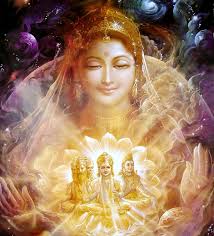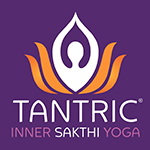
In the beginning the Nishkala Brahman alone existed. In the beginning there was the One. It willed and became many. Ahab bahu syam – “may I be many.” In such manifestation of Sakthi the Brahman is known as the lower (apara) or manifested Brahman, who, as the subject of worship, is meditated upon with attributes.
And, in fact, to the mind and sense of the embodied spirit (jiva) the Brahman has body and form. It is embodied in the forms of all Devas and Devils, and in the worshiper himself. Its form is that of the universe, and of all things and beings therein.
As Shruti says: “He saw” (Sa aikshata, aham bahu syam prajayeya). “He thought to Himself may I be many.” “Sa aikshaya” was itself a manifestation of Sakthi, the Para- mapurva-nirvana Sakthi, or Brahman as Sakthi. From the Brahman, with Sakthi (Para- Sakthi-maya) issued Nada (Shiva-Sakthi as the “Word” or “Sound” ), and from Nada, Bindu appeared. Kalicharana in his commentary on the Shatchakra-nirupana says that Shiva and Nirvana Sakthi bound by a mayik bond and covering, should be thought of as existing in the form of Parang Bindu.
The state of subtle body which is known as Kama-kala is the mula of mantra. The term mula-mantratmika, when applied to the Devi, refers to this subtle body of Hers known as the Kama-kala. The Tantra also speaks of three Bindus, namely Shiva-maya, Sakthi-maya, and Shiva-Sakthi-maya.
Tantric Inner Sakthi Yoga Sadhana focus on working with the subtle-body with mula mantra as practiced by Tantric seers.
Shaktism is a Goddess-centric tradition of Hinduism, wherein the metaphysical reality is considered metaphorically a woman and Shakti is regarded as the supreme godhead. It includes many goddesses, all considered aspects of the same supreme goddess. Shaktism has different sub-traditions, ranging from those focused on gracious Mother Parvati to that of fierce Mother Kali.

